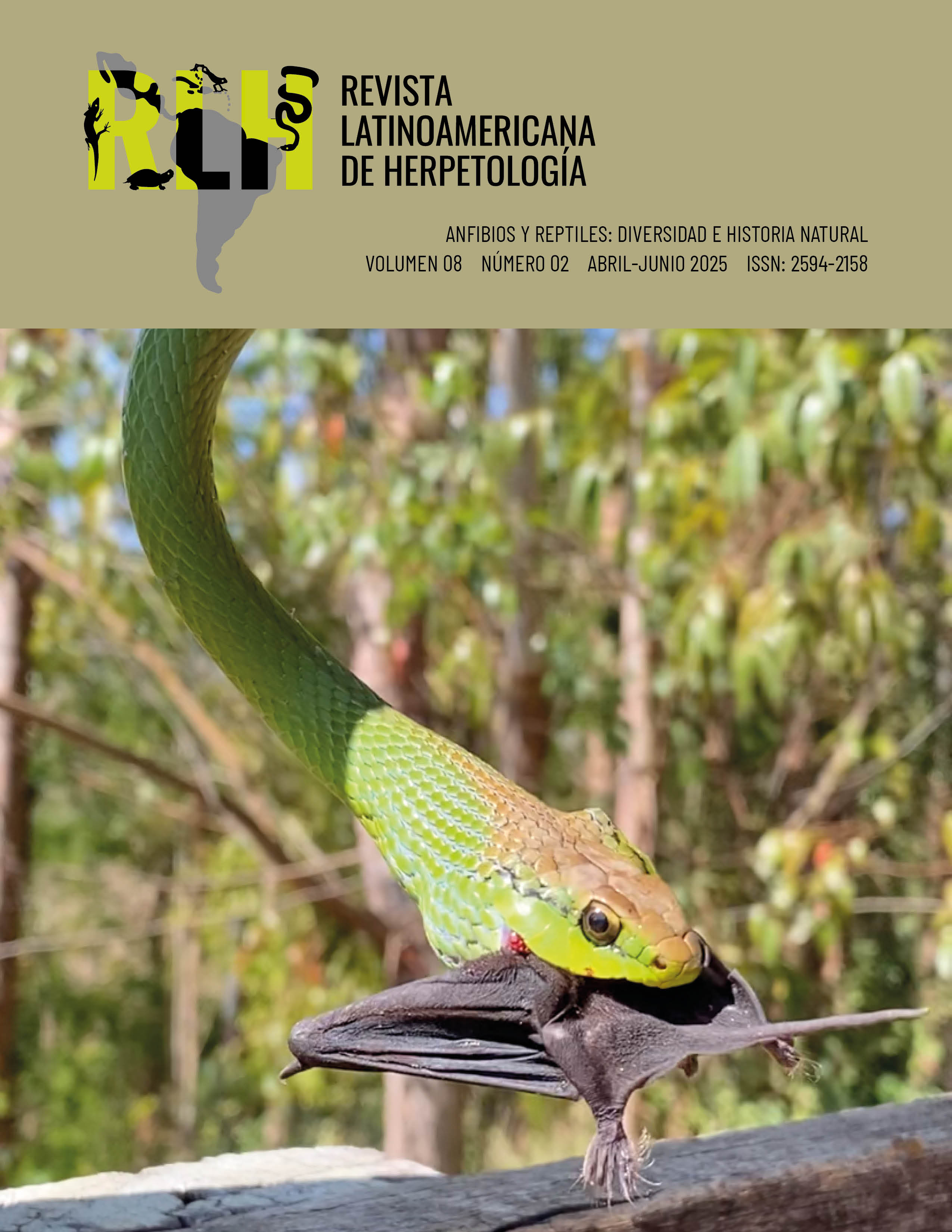DEATH OF AN ADULT Crotalus cerastes (VIPERIDAE) DUE TO INGESTION OF Dipsosaurus dorsalis (IGUANIDAE)
DOI:
https://doi.org/10.22201/fc.25942158e.2025.2.1164Keywords:
Diet, Intake, Mortality, SnakeAbstract
We report the mortality of a Sidewinder (Crotalus cerastes) by ingestion of a Desert Iguana (Dipsosaurus dorsalis) in Los Algodones, Mexicali, Baja California, Mexico. We found a dead individual of C. cerastes in a habitat composed of dunes, without any apparent physical injury that caused its death; however, we observed a large prey item recently ingested, which we identified as a D. dorsalis. The continual documentation of these cases in snakes helps identify ecological-evolutionary forces in prey size selection.
References
Arnold, S.J. 1993. Foraging theory and prey-size-predator-size relations in snakes. Pp. 87-115. In: R.A. Seigel & J.T. Collins (Eds.), Snakes: Ecology and Behavior. McGraw-Hill, Inc., New York, USA.
Bucio-Jiménez, L.E. & L. Fernández-Badillo. 2023. Mortalidad en Trimorphodon biscutatus (Colubridae) asociada a la ingesta de una Ctenosaura pectinata (Iguanidae) en Michoacán de Ocampo, México. Revista Latinoamericana de Herpetología 6:97-100.
Campbell, J.A. & W.W. Lamar. 2004. The Venomous Reptiles of the Western Hemisphere, Vol. II. Cornell University Press, Ithaca, New York, USA.
Cappellari, L.H., T. De Lema, Jr.P. Prates & C.F.D. Da Rocha. 2007. Diet of Teius oculatus (Sauria, Teiidae) in southern Brazil (Dom Feliciano, Rio Grande do Sul). Inheringia Série Zoologia 97:31-35.
Coupe, B. & J.E. Dawson. 2007. Crotalus cerastes (Sidewinder). Attempted feeding and mortality. Herpetological Review 38: 339-340.
Cundall, D. & H.W. Greene. 2000. Feeding in snakes. Pp. 293-333. In: Schwenk, K. (Ed.), Feeding: Form, Function and Evolution in Tetrapod Vertebrates. Academic Press, London, UK.
Ernst, C.H. & E.M. Ernst. 2003. Snakes of the United States and Canada. Smithsonian Books, Washington DC, USA.
Funk, R. 1965. Food of Crotalus cerastes laterorepens in Yuma County, Arizona. Herpetologica 21:15-17.
Gatica-Colima, A. & N. Córdova-Reza. 2012. Salvadora hexalepis deserticola (Big Bend Patchnosed Snake). Diet. Herpetological Review 43:350-351.
Hampton, P.M. 2017. Ontogenetic prey size selection in snakes: predator size and functional limitations to handling minimum prey sizes. Zoology (Jena, Germany) 126:103-109.
Kornilev, Y.V., N.D. Natchev & H.B. Lillywhite. 2023. Perils of ingesting harmful prey by advanced snakes. Biological reviews of the Cambridge Philosophical Society 98:263-283.
Shine, R. 1991. Why do larger snakes eat larger prey items? Functional Ecology 5:493-502.
Verrastro, L. & I. Ely. 2015. Diet of the lizard Liolaemus occipitalis in the coastal sand dunes of southern Brazil (Squamata: Liolaemidae). Brazilian Journal of Biology 75:289-299.
Vincent, S.E., B.R. Moon, R. Shine & A. Herrel. 2006. The functional meaning of "prey size" in water snakes (Nerodia fasciata, Colubridae) Oecologia 147:204-211.
Webber, M., T. Jezkova & J. Rodriguez-Roblez. 2016. Feeding Ecology of Sidewiner Rattlesnakes, Crotalus cerastes (Viperidae). Herpetologica 72:324-330.
Downloads
Published
How to Cite
Issue
Section
License
Copyright (c) 2025 Revista Latinoamericana de Herpetología

This work is licensed under a Creative Commons Attribution-NonCommercial-ShareAlike 4.0 International License.







